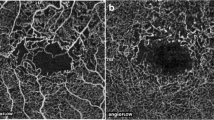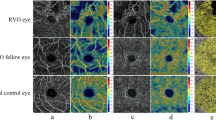Abstract
Purpose
To evaluate the changes in the choroidal structure in the setting of retinal vein occlusion (RVO).
Methods
Changes in the structure of the choroid were studied in sixty-four eyes with unilateral central or branch RVO using optical coherence tomography (OCT) with enhanced depth imaging and OCT-angiography (OCT-A). Choroidal vascularity index (CVI), Haller layer/choroidal thickness (H/C) ratio, and choriocapillaris flow density were used to compare the structural characteristics of the choroid with fellow eyes and the eyes of thirty-four age-, gender-, and systemic co-morbidity–matched controls.
Results
Eyes with RVO had a higher H/C ratio but a lower choriocapillaris flow density compared to both fellow and control eyes (p < 0.001). CVI was significantly lower in both eyes of the patients with RVO compared with control eyes (p < 0.05) with a more robust decrease in the eye that had developed RVO (p < 0.001). The H/C ratio (r = 0.303 p < 0.001), CVI (r = − 0.268, p = 0.001), and choriocapillaris flow density (r = − 0.237, p = 0.003) were all correlated with logMAR visual acuity, and other clinical features.
Conclusion
Retinal vein occlusions alter the hemodynamic properties of the choroid leading to structural changes. These changes may be secondary to a compensatory mechanism to supply oxygen to hypoxic retina.

Similar content being viewed by others
References
Keenan TD, Klein B, Agron E, Chew EY, Cukras CA, Wong WT (2020) Choroidal thickness and vascularity vary with disease severity and subretinal drusenoid deposit presence in nonadvanced age-related macular degeneration. Retina. https://doi.org/10.1097/iae.0000000000002434
Kim M, Ha MJ, Choi SY, Park Y-H (2018) Choroidal vascularity index in type-2 diabetes analyzed by swept-source optical coherence tomography. Sci Rep 8(1):70. https://doi.org/10.1038/s41598-017-18511-7
Agrawal R, Chhablani J, Tan KA, Shah S, Sarvaiya C, Banker A (2016) Choroidal vascularity index in central serous chorioretinopathy. Retina 36(9):1646–1651. https://doi.org/10.1097/iae.0000000000001040
Rayess N, Rahimy E, Ying GS, Pefkianaki M, Franklin J, Regillo CD, Ho AC, Hsu J (2016) Baseline choroidal thickness as a predictor for treatment outcomes in central retinal vein occlusion. Am J Ophthalmol 171:47–52. https://doi.org/10.1016/j.ajo.2016.08.026
Khodabandeh A, Shahraki K, Roohipoor R, Riazi-Esfahani H, Yaseri M, Faghihi H, Bazvand F (2018) Quantitative measurement of vascular density and flow using optical coherence tomography angiography (OCTA) in patients with central retinal vein occlusion: can OCTA help in distinguishing ischemic from non-ischemic type? Int J Retin Vitreous 4:47–47. https://doi.org/10.1186/s40942-018-0152-9
Mastropasqua R, Toto L, Di Antonio L, Borrelli E, Senatore A, Di Nicola M, Di Martino G, Ciancaglini M, Carpineto P (2017) Optical coherence tomography angiography microvascular findings in macular edema due to central and branch retinal vein occlusions. Sci Rep 7:40763. https://doi.org/10.1038/srep40763
Du KF, Xu L, Shao L, Chen CX, Zhou JQ, Wang YX, You QS, Jonas JB, Wei WB (2013) Subfoveal choroidal thickness in retinal vein occlusion. Ophthalmology 120(12):2749–2750. https://doi.org/10.1016/j.ophtha.2013.08.031
Chylack LT Jr, Wolfe JK, Singer DM, Leske MC, Bullimore MA, Bailey IL, Friend J, McCarthy D, Wu SY (1993) The lens opacities classification system III. The longitudinal study of cataract study group. Arch Ophthalmol 111(6):831–836. https://doi.org/10.1001/archopht.1993.01090060119035
Chung YR, Kim JW, Choi SY, Park SW, Kim JH, Lee K (2018) Subfoveal choroidal thickness and vascular diameter in active and resolved central serous chorioretinopathy. Retina 38(1):102–107. https://doi.org/10.1097/iae.0000000000001502
Sonoda S, Sakamoto T, Yamashita T, Shirasawa M, Uchino E, Terasaki H, Tomita M (2014) Choroidal structure in normal eyes and after photodynamic therapy determined by Binarization of optical coherence tomographic ImagesBinarization of OCT on choroid. Invest Ophthalmol Vis Sci 55(6):3893–3899. https://doi.org/10.1167/iovs.14-14447
Mrejen S, Spaide RF (2013) Optical coherence tomography: imaging of the choroid and beyond. Surv Ophthalmol 58(5):387–429. https://doi.org/10.1016/j.survophthal.2012.12.001
Shao Z, Dorfman AL, Seshadri S, Djavari M, Kermorvant-Duchemin E, Sennlaub F, Blais M, Polosa A, Varma DR, Joyal JS, Lachapelle P, Hardy P, Sitaras N, Picard E, Mancini J, Sapieha P, Chemtob S (2011) Choroidal involution is a key component of oxygen-induced retinopathy. Invest Ophthalmol Vis Sci 52(9):6238–6248. https://doi.org/10.1167/iovs.10-6742
Lutty GA, Otsuji T, Taomoto M, Merges C, McLeod DS, Kim SY, Vanderslice P, Suzuka S, Fabry ME, Nagel RL (2002) Mechanisms for sickle red blood cell retention in choroid. Curr Eye Res 25(3):163–171. https://doi.org/10.1076/ceyr.25.3.163.13481
Gallice M, Zhou T, Aptel F, Verges S, Riva C, Geiser M, Chiquet C (2017) Hypoxic, hypercapnic, and hyperoxic responses of the optic nerve head and subfoveal choroid blood flow in healthy humans. Invest Ophthalmol Vis Sci 58(12):5460–5467. https://doi.org/10.1167/iovs.17-21855
Tsuiki E, Suzuma K, Ueki R, Maekawa Y, Kitaoka T (2013) Enhanced depth imaging optical coherence tomography of the choroid in central retinal vein occlusion. Am J Ophthalmol 156(3):543–547.e541. https://doi.org/10.1016/j.ajo.2013.04.008
Wei WB, Xu L, Jonas JB, Shao L, Du KF, Wang S, Chen CX, Xu J, Wang YX, Zhou JQ, You QS (2013) Subfoveal choroidal thickness: the Beijing eye study. Ophthalmology 120(1):175–180. https://doi.org/10.1016/j.ophtha.2012.07.048
Lee EK, Han JM, Hyon JY, Yu HG (2015) Changes in choroidal thickness after intravitreal dexamethasone implant injection in retinal vein occlusion. Br J Ophthalmol 99(11):1543–1549. https://doi.org/10.1136/bjophthalmol-2014-306417
Johnson M, McLaren JW, Overby DR (2017) Unconventional aqueous humor outflow: a review. Exp Eye Res 158:94–111. https://doi.org/10.1016/j.exer.2016.01.017
Hollborn M, Rehak M, Iandiev I, Pannicke T, Ulbricht E, Reichenbach A, Wiedemann P, Bringmann A, Kohen L (2012) Transcriptional regulation of aquaporins in the ischemic rat retina: upregulation of aquaporin-9. Curr Eye Res 37(6):524–531. https://doi.org/10.3109/02713683.2012.658133
Schroder K, Ackermann P, Brachert M, Bairov S, Geerling G, Guthoff R (2016) Does OCT morphology provide indications for prognosis of visual acuity after venous occlusion? : SD-OCT analysis in retinal vein occlusion before and after resolution of initial macular edema. Ophthalmologe 113(6):500–506. https://doi.org/10.1007/s00347-016-0234-8
Costanzo E, Parravano M, Gilardi M, Cavalleri M, Sacconi R, Aragona E, Varano M, Bandello F, Querques G (2019) Microvascular retinal and choroidal changes in retinal vein occlusion analyzed by two different optical coherence tomography angiography devices. Ophthalmologica 242(1):8–15. https://doi.org/10.1159/000496195
Saint-Geniez M, Kurihara T, Sekiyama E, Maldonado AE, D'Amore PA (2009) An essential role for RPE-derived soluble VEGF in the maintenance of the choriocapillaris. Proc Natl Acad Sci U S A 106(44):18751–18756. https://doi.org/10.1073/pnas.0905010106
Marneros AG, Fan J, Yokoyama Y, Gerber HP, Ferrara N, Crouch RK, Olsen BR (2005) Vascular endothelial growth factor expression in the retinal pigment epithelium is essential for choriocapillaris development and visual function. Am J Pathol 167(5):1451–1459. https://doi.org/10.1016/s0002-9440(10)61231-x
Julien S, Biesemeier A, Taubitz T, Schraermeyer U (2014) Different effects of intravitreally injected ranibizumab and aflibercept on retinal and choroidal tissues of monkey eyes. Br J Ophthalmol 98(6):813–825. https://doi.org/10.1136/bjophthalmol-2013-304019
Woo SC, Lip GY, Lip PL (2016) Associations of retinal artery occlusion and retinal vein occlusion to mortality, stroke, and myocardial infarction: a systematic review. Eye (Lond) 30(8):1031–1038. https://doi.org/10.1038/eye.2016.111
Chen YY, Yen YF, Lin JX, Feng SC, Wei LC, Lai YJ, Shen YC (2018) Risk of ischemic stroke, hemorrhagic stroke, and all-cause mortality in retinal vein occlusion: a nationwide population-based cohort study. J Ophthalmol 2018:8629429. https://doi.org/10.1155/2018/8629429
Wu CY, Riangwiwat T, Limpruttidham N, Rattanawong P, Rosen RB, Deobhakta A (2019) Association of retinal vein occlusion with cardiovascular events and mortality: a systematic review and meta-analysis. Retina 39(9):1635–1645. https://doi.org/10.1097/iae.0000000000002472
Chua J, Chin CWL, Tan B, Wong SH, Devarajan K, Le TT, Ang M, Wong TY, Schmetterer L (2019) Impact of systemic vascular risk factors on the choriocapillaris using optical coherence tomography angiography in patients with systemic hypertension. Sci Rep 9(1):5819. https://doi.org/10.1038/s41598-019-41917-4
Ayhan Z, Kaya M, Ozturk T, Karti O, Oner FH (2017) Evaluation of macular perfusion in healthy smokers by using optical coherence tomography angiography. Ophthalmic Surg Lasers Imaging Retina 48(8):617–622. https://doi.org/10.3928/23258160-20170802-03
Okamoto M, Yamashita M, Sakamoto T, Ogata N (2018) Choroidal blood flow and thickness as predictors for response to anti-vascular endothelial growth factor therapy in macular edema secondary to branch retinal vein occlusion. Retina 38(3):550–558. https://doi.org/10.1097/iae.0000000000001566
Author information
Authors and Affiliations
Corresponding author
Ethics declarations
Conflict of interest
The authors declare that they have no conflict of interest.
Ethics approval
Received from the Gazi University’s Institutional Review Board.
Consent to participate
The study received a waiver for consent.
Consent for publication
This manuscript does not contain personal and/or medical information about an identifiable living individual.
Additional information
Publisher’s note
Springer Nature remains neutral with regard to jurisdictional claims in published maps and institutional affiliations.
Rights and permissions
About this article
Cite this article
Aribas, Y.K., Hondur, A.M. & Tezel, T.H. Choroidal vascularity index and choriocapillary changes in retinal vein occlusions. Graefes Arch Clin Exp Ophthalmol 258, 2389–2397 (2020). https://doi.org/10.1007/s00417-020-04886-3
Received:
Revised:
Accepted:
Published:
Issue Date:
DOI: https://doi.org/10.1007/s00417-020-04886-3




